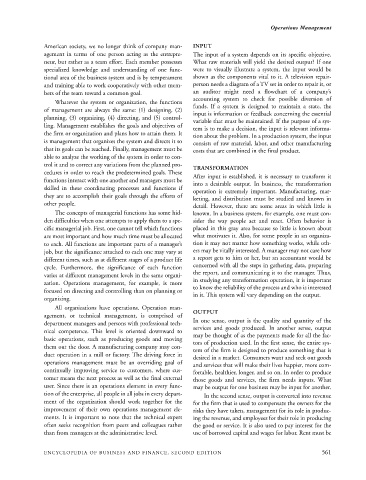Page 584 - Encyclopedia of Business and Finance
P. 584
eobf_O 7/5/06 3:17 PM Page 561
Operations Management
American society, we no longer think of company man- INPUT
agement in terms of one person acting as the entrepre- The input of a system depends on its specific objective.
neur, but rather as a team effort. Each member possesses What raw materials will yield the desired output? If one
specialized knowledge and understanding of one func- were to visually illustrate a system, the input would be
tional area of the business system and is by temperament shown as the components vital to it. A television repair-
and training able to work cooperatively with other mem- person needs a diagram of a TV set in order to repair it, or
bers of the team toward a common goal. an auditor might need a flowchart of a company’s
accounting system to check for possible diversion of
Whatever the system or organization, the functions
of management are always the same: (1) designing, (2) funds. If a system is designed to maintain a state, the
input is information or feedback concerning the essential
planning, (3) organizing, (4) directing, and (5) control-
variable that must be maintained. If the purpose of a sys-
ling. Management establishes the goals and objectives of
tem is to make a decision, the input is relevant informa-
the firm or organization and plans how to attain them. It
tion about the problem. In a production system, the input
is management that organizes the system and directs it so consists of raw material, labor, and other manufacturing
that its goals can be reached. Finally, management must be costs that are combined in the final product.
able to analyze the working of the system in order to con-
trol it and to correct any variations from the planned pro-
TRANSFORMATION
cedures in order to reach the predetermined goals. These
After input is established, it is necessary to transform it
functions interact with one another and managers must be
into a desirable output. In business, the transformation
skilled in these coordinating processes and functions if
operation is extremely important. Manufacturing, mar-
they are to accomplish their goals through the efforts of
keting, and distribution must be studied and known in
other people.
detail. However, there are some areas in which little is
The concepts of managerial functions has some hid- known. In a business system, for example, one must con-
den difficulties when one attempts to apply them to a spe- sider the way people act and react. Often behavior is
cific managerial job. First, one cannot tell which functions placed in this gray area because so little is known about
are most important and how much time must be allocated what motivates it. Also, for some people in an organiza-
to each. All functions are important parts of a manager’s tion it may not matter how something works, while oth-
job, but the significance attached to each one may vary at ers may be vitally interested. A manager may not care how
different times, such as at different stages of a product life a report gets to him or her, but an accountant would be
cycle. Furthermore, the significance of each function concerned with all the steps in gathering data, preparing
the report, and communicating it to the manager. Thus,
varies at different management levels in the same organi-
in studying any transformation operation, it is important
zation. Operations management, for example, is more
to know the reliability of the process and who is interested
focused on directing and controlling than on planning or
in it. This system will vary depending on the output.
organizing.
All organizations have operations. Operation man-
OUTPUT
agement, or technical management, is comprised of
In one sense, output is the quality and quantity of the
department managers and persons with professional tech-
services and goods produced. In another sense, output
nical competence. This level is oriented downward to
may be thought of as the payments made for all the fac-
basic operations, such as producing goods and moving
tors of production used. In the first sense, the entire sys-
them out the door. A manufacturing company may con-
tem of the firm is designed to produce something that is
duct operation in a mill or factory. The driving force in
desired in a market. Consumers want and seek out goods
operations management must be an overriding goal of
and services that will make their lives happier, more com-
continually improving service to customers, where cus- fortable, healthier, longer, and so on. In order to produce
tomer means the next process as well as the final external those goods and services, the firm needs inputs. What
user. Since there is an operations element in every func- may be output for one business may be input for another.
tion of the enterprise, all people in all jobs in every depart- In the second sense, output is converted into revenue
ment of the organization should work together for the for the firm that is used to compensate the owners for the
improvement of their own operations management ele- risks they have taken, management for its role in produc-
ments. It is important to note that the technical expert ing the revenue, and employees for their role in producing
often seeks recognition from peers and colleagues rather the good or service. It is also used to pay interest for the
than from managers at the administrative level. use of borrowed capital and wages for labor. Rent must be
ENCYCLOPEDIA OF BUSINESS AND FINANCE, SECOND EDITION 561

